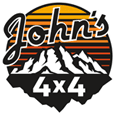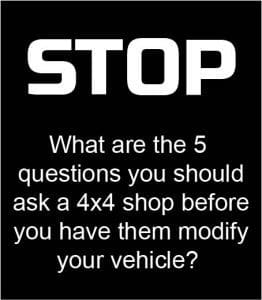Want to get a Jeep and a Jeep Lift Kit? – What to Look for When Buying a Jeep
So you are looking to get a Jeep lift kit? First start off with a checklist of your needs.
What do you get with a Rubicon over other models? Rubicon is a no-brainer if you plan on going off road — unless you plan on upgrading axles. A huge difference in JK over JL non Rubicon is that JL’s have smaller rear axles than the JK did. The right Jeep needs the right Jeep lift kit.
JK Dana 30 HP and Dana 44 Rear Axles No Lockers
-
- Dana 44 front and rear with 4.11 gears and e lockers
-
- Crawl control, offroad transfer case giving better crawl ratio
-
- Small 1” lift over other models
-
- Better fenders allowing larger tires
-
- Electronic sway bar disconnect – push of a button allowing more articulation
JL Dana 30 HP and Small Dana 35 Rear Axles No Lockers
-
- Dana 44 front and rear with 4.11 gears and e lockers
-
- These axles are stronger than the JK D44
-
- Crawl control, offroad transfer case giving better crawl ratio
-
- Small 1” lift over other models
-
- Better fenders allowing larger tires
- Electronic sway bar disconnect – push of a button allowing more articulation
What Do You Get With JL Over JK?
Better interior, infotainment system, improved steering system, lower interior noise levels, and most notably an 8 speed automatic transmission which gives the feeling of more power due to its gearing. It also allows for larger tires without the need to regear as you would a JK. Our rental JL has 37” tires and stock gears and it can do a burnout on dry pavement, and with low range 4×4 it has plenty of crawling power while off road. The transmission alone saves you a whopping $2500-3,000 instead of regearing if you install larger tires.
Do you plan on off roading? If so, what size tire and wheel do you want to run? We typically recommend staying with 17” wheels for added tire sidewall for better off road performance. Larger wheels do not perform well on or off road. These are things people often forget to consider when looking for a jeep lift kit.
How big of a tire is too much for my Jeep Non Rubicon? Depends on use. Without a locker and with safe driving, 35” tires are acceptable. However with lockers and aggressive driving, 35’s could damage the axles, especially the front.
This is why a Rubicon is amazing. With the drastically larger Dana 44 front axle with lockers you can safely run 37” tires with safe driving. There’s always someone who can push the limits and break or damage the axles regardless of tire size.
For the most part anything past 37” will require more modifications.
What Kind of Jeep Lift kit is Best for Me?
You have decided you want a Jeep lift kit but what jeep lift kit is the best for you?
Control arms center the axle forward and backward under the vehicle. They also control the alignment of the vehicle as well as driveline angles.
Short arm lift kits are good for 3.5” of lift if adjustable for alignment and driving characteristics. Going down the road straight without death wobble.
We typically stay at 2.5” of lift on stock control arms if alignment bolts are used to maintain a proper alignment and keep death wooble away.
Past 3.5” we recommend long arms. Long arms reduce the angle and correct geometry for a large lift. They also articulate extremely well. For ride quality and off roading purposes, long arms are a huge improvement.
What if the vehicle has adjustable upper control arms? What does this benefit? Upper control arms are mainly used to allow adjustment of the pinion angle or driveline angle. Too little or large of an angle can cause vibrations and joint replacement intervals will be smaller.
Most commonly replaced are the adjustable lowers to center the axle under the vehicle. Because when you lift the vehicle the geometry changes and the stock length arm will pull the tire backwards towards the rear of the fender well.
More adjustment is better but not always required. If you have all adjustable arms we can actually set wheelbase and have the ability to get the vehicle to drive better than factory.
The track bar is like a control arm but for horizontal adjustment. The track bar centers the axle under the vehicle side to side. Think if one tire on the passenger side sits further outside the wheel well than the drivers side. This vehicle needs an adjustable track bar or an adjustment on it.
As you lift a vehicle, the track bar’s geometry changes and due to its angle it pulls the axle over to one side This can cause dog tracking where the vehicle drives straight but drives diagonally. You may have seen this as it looks very odd.
Stock track bars are weak! Time and time again, we see stock track bars that actually flex and bend under normal driving. We recommend a heavy duty replacement that is also adjustable. Our favorite is the Rubicon Express Forged track bar for JK, JL, and JT. It offers a lifetime warranty adjustment between 0 and 6” lift. Remember, stock height Jeeps are not free from needing this.
Shocks
Stock shocks on a lifted vehicle? Not recommended. While it may be fine during street driving, when off road if the suspension articulates, the shocks will over extend or bottom out, causing damage to them. Poor ride quality will also be noticed. Any grease or oil leaks indicate a bad shock, but even if they aren’t leaking, they may have internally failed.
Jeep Lift Kit Pucks or Spacers
Lift spacers can be great if used accordingly. Unfortunately, manufacturers say they will work great for the vehicle with no other supporting modifications. Unfortunately this is not the case.
We just recently experienced this. The new JT Gladiator Jeep pickups offer a spacer to level the front end out. They claimed it wouldn’t need other modifications. However, we needed to add sway bar links to correct the sway bar geometry and prevent rubbing of suspension components — as well as an adjustable track bar. Without the adjustable track bar, the sway bar links were out of alignment and the axle was off center by over an inch! Our trusty Rubicon Express Forged track bar was the perfect solution for this.
Steering Stabilizer
This is a dampener for steering components. Factory units are very tiny and work okay for stock tires, but with Larger wheels and tires, a heavy duty shock is recommended and required to dampen steering components. A bad dampener could resemble death wobble. We have come to find that the OME steering dampeners are the strongest and eliminate any problems with a steering dampener without the need for dual stabilizers. Any grease or oil leaks indicate a bad shock, but even if they aren’t leaking they may have internally failed.
The rear track bar is usually strong enough to just use a drop or relocation bracket to correct geometry. While adjustable is always better, most of our lift packages include a relocation. However a huge problem occurs very often if you use an axle side relocation. This taller mount puts added stress to the original mount and actually rips off the track bar mount from the axle, leading to a very dangerous and undrivable vehicle. We always recommend the frame side relocation mount because it bolts to the frame with more bolts and the frame is much stronger. We have never had an issue with our brackets.
Progressive rate or multi rate springs are designed to be soft where you want it and firm when you want it for ride comfort and articulation benefits. Our JK rental has these equipped and rides phenomenally. These springs from Rubicon Express are the same cost as traditional — you just need to know to ask for them. We always recommend them.
Sway Bar
The factory sway bars are usually maintained, however as you lift the vehicle the geometry changes and end links need to be corrected to prevent suspension rubbing and handling characteristics. Make sure the sway bar is not pointing downward.
Disconnects
Unless you have a fancy schmancy Rubicon with electronic sway bar disconnects to allow suspension articulation when off road, you will need quick disconnects to separate the end links from the axle or sway bar to inhibit articulation. These are commonly adjustable as well.
Spare Tire Mount
Anything past 35” is putting too much stress on the factory spare tire mount and even then there may be a spacer to allow it to fit. We recommend a braced unit to handle the weight and fit the larger tire on there. A lot of times we can get away with a relocation bracket and some anti rattle bump stops to support the tire.
Ball Joints
These are the joints that allow your vehicle’s front wheels to turn as they mount the steering knuckle to the axle. They are very common on Jeeps, especially the JK series. Unfortunately stock units are weak and it’s not uncommon for us to see a new JK jeep with 10,000 miles on it needing ball joints — especially if the vehicle has been off road. We recommend heavy duty upgraded joints with camber and castor adjustment for alignment purposes. Usually Jeeps have some camber that can only be solved with an adjustable joint.

